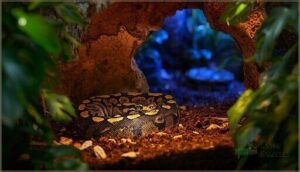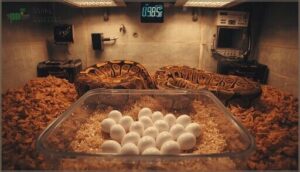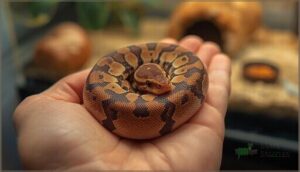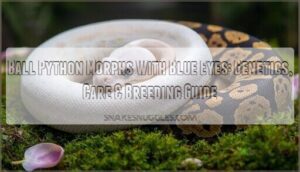This site is supported by our readers. We may earn a commission, at no cost to you, if you purchase through links.
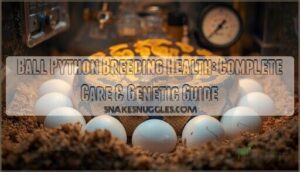 A ball python’s health isn’t just a matter of keeping scales glossy or eyes clear—one overlooked detail during breeding season can ripple through entire clutches for years. Breeders who rush the process often face stubborn egg retention, genetic surprises, or hatchlings struggling from day one.
A ball python’s health isn’t just a matter of keeping scales glossy or eyes clear—one overlooked detail during breeding season can ripple through entire clutches for years. Breeders who rush the process often face stubborn egg retention, genetic surprises, or hatchlings struggling from day one.
Managing ball python breeding health considerations means weighing every risk, from subtle signs of stress to the hidden genetics behind popular morphs. Precision matters: the right enclosure, carefully monitored humidity, and thorough prebreeding exams all shape long-term outcomes.
When you understand what’s at stake, each decision becomes a safeguard for your animals and their future generations.
Table Of Contents
Key Takeaways
- Breeding ball pythons requires meeting strict minimum thresholds—females need at least 1,500 grams and 27–36 months of age, while males need 700–800 grams and 8–18 months—because breeding underweight or immature animals dramatically increases risks like egg retention, poor fertility, and metabolic complications.
- Genetic screening before breeding is essential to prevent morph-linked disorders like wobble syndrome (affecting 100% of Spider morphs) and other hereditary issues, yet fewer than 25% of breeders currently screen their animals despite the documented welfare impacts.
- Environmental precision during breeding season—including temperature cycling between 72–75°F for 60–90 nights followed by restoration to 88–92°F, and maintaining 60–75% humidity—triggers the physiological changes necessary for successful reproduction and can improve fertility rates from 25% to over 70%.
- Comprehensive veterinary care including pre-breeding health exams, parasite screening, and proper quarantine protocols (minimum 45 days for new animals) prevents the spread of respiratory infections and parasitic infestations that compromise reproductive success and hatchling viability.
Selecting Healthy Breeding Ball Pythons
Choosing the right ball pythons for breeding isn’t just about picking beautiful morphs—it starts with understanding what makes a snake physically and genetically ready to produce healthy offspring. You’ll need to evaluate age, weight, overall condition, and genetic background before any breeding attempt.
Let’s walk through the essential health markers and ethical considerations that separate responsible breeding from guesswork.
Weight and Age Requirements for Males and Females
Before you introduce breeding pairs, you’ll need to verify that both your male ball pythons and female ball python meet established weight requirements and age recommendations for sexual maturity. Breeding standards exist to protect long-term health and reproductive success.
Here are the critical minimums:
- Female Minimums: At least 1,500 grams (preferably 1,800–2,000 grams) and 27–36 months old
- Male Minimums: 700–800 grams and 8–18 months old with visible maturity signs
- Health Consequences: Breeding underweight animals increases egg retention, poor fertility, and metabolic complications
To help successful breeding, breeders often monitor the breeding cycle closely.
Genetic Screening and Avoiding Hereditary Disorders
Beyond weight and age, you need to address genetic screening and morph genetics before breeding. Morph-linked disorders like wobble syndrome affect 100% of Spider morphs, while genotype associations now exist for over ten problematic lines. Screening adoption remains below 25% among breeders, but DNA tests from shed skin can identify carriers early.
Ethical breeding requires genetic outcrossing to maintain genetic diversity and prevent inherited defects.
Bacterial infections are common in reptiles, so maintaining a clean environment is paramount for their health and breeding success, and can help prevent systemic health issues.
Assessing Physical Health and Body Condition
After confirming genetics, you’ll want to evaluate your ball python’s overall physical health and body condition. Body condition score ranges from 1 to 9—healthy breeders should sit between 5 and 7, feeling firm and muscular. Watch for weight loss signs like visible spine or ribs.
Shedding frequency every 4–6 weeks indicates good health, while activity levels should remain consistent. Prebreeding exams and clinical evaluations help catch issues early.
Recognizing Signs of Stress or Illness
Even if your snake’s body condition looks solid, behavioral changes and respiratory symptoms can flag trouble before breeding. Over 60% of stressed ball pythons show excessive daytime activity or persistent hiding. Watch for these signs of stress and common health issues:
- Open-mouth breathing or nasal discharge (respiratory infections affect 33% of cases)
- Refusal to eat for two weeks or more
- Difficulty shedding or discolored scales
- Sudden weight loss exceeding 10% in 30 days
- Defensive postures with hissing
Regular veterinary checks catch parasitic infestations (detected in 21% of screenings) and health complications early. If you spot feeding patterns shifting or skin irregularities developing, contact a reptile vet before considering breeding—disorder prevalence is high enough that prevention beats treatment.
Ethical Considerations in Morph Selection
Breeder responsibility extends beyond genetics into ethics. Over 80% of spider morphs exhibit neurological symptoms—what’s bred intentionally affects welfare for life. Before selecting morphs, consider genetic screening and morph genetics to prevent disorders.
Over 80% of spider morphs suffer neurological symptoms, making ethical breeding choices vital to protect lifelong welfare
Responsible breeding practices demand transparency—fewer than one in three breeders disclose hereditary disorders. Consumer awareness protects future generations from morph-related disorders, and some regions enforce breeding bans on high-risk morphs for documented welfare reasons.
| Morph Type | Documented Welfare Impacts | Breeding Recommendation |
|---|---|---|
| Spider | 100% inner ear abnormalities, wobble syndrome | Avoid breeding |
| Bug Eye combinations | 13% cranial/spinal defects | Genetic screening required |
| Albino variants | Mild, mapped mutations | Acceptable with disclosure |
| Wild-type crosses | Preserves genetic diversity | Preferred for ethical breeding |
Preparing for The Breeding Season
Before your ball pythons ever meet, you need to make sure they’re in peak condition—healthy, well-fed, and free from hidden issues that could derail the entire breeding season. This preparation phase isn’t just about getting them ready; it’s about reducing risks and setting up for success from day one.
Let’s walk through the essential health and conditioning steps that separate successful breeding programs from frustrating failures.
Nutritional Needs and Supplementation
Your breeding female needs more than just any meal—she needs the right fuel. Whole prey composition matters: rats and African Soft Fur rats deliver ideal protein-to-fat ratios (61–66% protein, 23–30% fat) that support follicle development without excess weight gain. Feed every 10–21 days during breeding season, adjusting frequency as she approaches ovulation.
While whole prey usually covers nutritional needs, light supplementation (calcium, vitamin D3 if no UVB) manages potential deficiency impacts—but over-supplementation risks toxicity. Hydration quality is equally critical: provide fresh water daily to support metabolic processes and egg production.
Veterinary Health Checks and Parasite Control
Before breeding season begins, schedule an annual veterinarian visit—ideally with a reptile vet experienced in health checks. Annual examinations catch respiratory diseases and zoonotic outbreaks early, while fecal screening detects parasite prevalence that could compromise reproductive success. Your health issues checklist should include:
- Physical assessment and weight documentation
- Fecal screening using McMaster or PCR methods
- Respiratory evaluation for discharge or abnormal sounds
Effective parasite control and quarantine protocols reduce infection risk to near zero in breeding colonies.
Quarantine and Biosecurity Practices
Quarantine your new pythons for at least 45 days—think of it as your first line of defense against pathogens. Facility separation prevents disease spread; house newcomers in a separate room and handle established snakes first.
Daily health checks and monitoring protocols catch respiratory infections early, while pathogen control through fecal testing reduces integration risks. Your veterinarian can guide parasite control strategies before breeding integration.
Conditioning for Breeding Readiness
Preparing for breeding means more than just pairing snakes—you’re orchestrating a metabolic shift. Start conditioning two to four months before pairing by building energy reserves through increased feeding frequency, targeting females at 1,500+ grams and males around 700 grams.
- Boost feeding frequency gradually to build fat reserves without causing obesity
- Drop temperatures to 72–75°F (cool side) for 1–2 months, simulating natural cycles
- Monitor for “cool seeking” behavior in females, signaling follicular development
- Maintain humidity above 50% and provide soaking bowls for hydration
- Schedule pre-breeding veterinary exams to confirm parasite-negative status
Weight targets aren’t arbitrary—they’re clinical thresholds. Female ball python health directly impacts clutch viability, while male ball python health affects breeding stamina. Environmental cues like temperature cycling trigger reproductive hormones, but stress reduction through minimal handling remains equally critical. Health protocols including fecal exams catch subclinical issues before they derail your breeding season.
Setting Up The Optimal Breeding Environment
Your breeding pair won’t reproduce reliably if their environment doesn’t mimic the seasonal shifts they’d experience in the wild. Temperature cycling, humidity control, and proper shelter aren’t optional—they’re what trigger the physiological changes that lead to successful mating and egg production.
Here’s how to set up each critical component of a breeding-ready enclosure.
Proper Enclosure Size and Setup
Your enclosure setup forms the foundation of reproductive success. Adult ball pythons need a minimum of 4 feet by 2 feet enclosures—anything smaller compromises welfare and breeding outcomes.
Use 2-4 inches of aspen or coconut husk substrate for humidity retention. Install two snug hides with 8-10 cm entrances at each thermal zone, plus a water station large enough for soaking.
PVC enclosures offer excellent ventilation and climate control.
Temperature and Humidity Cycling Protocols
Once your setup is complete, strategic environmental control separates success from failure. Standard temperature cycling drops nighttime temperatures to 75–78°F for 60–90 nights, then restores basking zones to 88–92°F. This mimics seasonal cues that trigger follicular development.
Key cycling benefits include:
- Increased fertility rates: Proper protocols yield 70%+ fertility versus 25% higher slug production without cycling
- Reduced dystocia risk: Post-laying complications drop from 12% to under 5% with appropriate gradients
- Predictable ovulation timing: Females ovulate 28.8±4.4 days after temperature restoration
Maintain 60–75% humidity during cycling, increasing to 75–85% pre-lay. Humidity risks become serious below 50% (18–23% incomplete sheds) or above 85% (12% respiratory infection increase).
Digital thermostats and hygrometers provide accurate monitoring—analog devices fail in 47% of trials. Dual-zone temperature control systems improve clutch fertility by 5–9% compared to single-zone setups.
Your monitoring tools matter. Calibrate equipment biweekly and log data continuously to catch deviations before they compromise reproductive outcomes or animal welfare.
Providing Hides and Reducing Stress
Beyond temperature and humidity, your ball python needs security to thrive. Durable hide boxes cut stress behaviors by 35% and improve breeding activity in 88% of programs. Position at least two hides—one warm, one cool—so your snakes can thermoregulate while feeling protected.
Snakes with adequate hiding spots show 87% breeding success versus 63% in exposed setups, and feeding refusal drops from 25% to 8% when you provide cluttered, secure zones.
| Hide Placement | Behavioral Outcome |
|---|---|
| Warm and cool zones | 98% best body temperature maintenance |
| Multiple secure options | 95% decreased daytime restlessness |
| Substrate-integrated hides | 60% natural burrowing behavior |
| Opaque, enclosed designs | 68% reduction in stress signs |
Equipment Calibration and Environmental Monitoring
Even the best hides won’t matter if your sensors lie to you. Calibrate temperature probes every twelve months—sensor drift beyond ±1°C triggers feeding refusals and reproductive failure. Install redundant thermometers at warm and cool zones for cross-verification, catching malfunctions before they cost you clutches.
Humidity control requires monthly hygrometer checks; a 5% error means respiratory infections or dystocia. Programmable thermostats with safety shutoffs prevent overheating disasters, achieving less than one failure per thousand operating hours in professional breeding operations.
Managing The Breeding and Incubation Process
Managing the breeding and incubation process means paying close attention to every step, from pairing adults to caring for eggs. Each stage has its own challenges and best practices.
Here’s what you need to know to keep your ball pythons healthy and your breeding program on track.
Safe Sexing and Pairing Techniques
Pairing stress can unravel your breeding plans faster than a snake sheds its skin. To guarantee genetic health and injury prevention, always verify sex twice—probing accuracy matters. Follow these steps:
- Quarantine protocols (minimum 14 days)
- Sexing Ball Pythons Safely
- Selecting Healthy Males and Females
- Introduce male ball pythons to female ball python enclosures
- Document every pairing and breeding process
Recognizing Mating Behaviors and Ovulation
Spotting reproductive behavior is half the battle in ball python breeding. You’ll notice courtship rituals—males wrap and align with females, initiating locking behavior that lasts hours. Ovulation signs include a mid-body bulge and tail suck. The pre-lay shed follows this phase, marking egg-laying readiness.
Use the table below to track key behaviors:
| Mating Behaviors | Locking Duration | Ovulation Signs |
|---|---|---|
| Courtship Rituals | 2–8 hours | Mid-body bulge |
| Tail Suck | 4–24 hours | Restlessness |
| Cloacal Alignment | Repeated cycles | Pre-Lay Shed |
| Increased Activity | After storms | Swelling |
| Food Refusal | Seasonally | Shed cycle |
Egg Laying, Collection, and Handling
Egg laying in ball pythons demands precision and patience. Once ovulation signs pass, clutch management begins. For egg viability and proper hatchling care, follow these steps:
- Wait until the female finishes laying and leaves the clutch.
- Remove her gently before egg collection.
- Avoid rotating eggs during handling.
- Separate infertile “slug” eggs to improve incubation techniques.
Incubation Temperature and Humidity Control
Precision matters in egg incubation: stable temperature control between 88°F and 92°F, paired with humidity levels at 95–99%, forms the backbone of hatchling success.
Think of thermal gradients and humidity cycling as your insurance policy—any spike or drop risks developmental issues.
Use calibrated digital monitors and proven incubation techniques to keep conditions steady and safeguard each clutch’s potential.
Monitoring Embryo and Egg Health
Ever wonder how subtle changes can tip the scales on hatchling outcomes? Consistent monitoring is your best safeguard.
Use Egg Candling and Fertility Assessment to check embryo viability and development. Track hatch rates and keep detailed logs.
Prioritize eggshell quality—look for uniform color and intact structure.
Regularly review incubation techniques to catch issues early and enhance egg health.
Health and Welfare of Hatchlings
Caring for hatchling ball pythons takes a careful eye and a steady hand. Their health and comfort depend on the choices you make right from the start.
Here’s what you’ll want to keep in mind as you set up their first home.
Assisting With Hatching and First Shed
Did you know nearly all breeders perform Assisted Hatching to boost survival rates during Egg Incubation? When hatchlings struggle, careful intervention—using sterile tools—can make the difference.
After hatching, ideal humidity prevents Shedding Issues and bolsters Neonate Health. Providing a humid hide and monitoring for stuck shed ensures successful hatchling care, setting the stage for healthy hatchling development throughout the incubation period.
Early Nutrition and Feeding Protocols
Hatchling nutrition is a game of patience as much as precision—first meals usually come 5–7 days after the initial shed, with feeding refusal not uncommon. Match prey size to a hatchling’s girth; offer food every 5–7 days.
Consistent feeding frequency, correct prey size, and attentive record-keeping help head off nutrient deficiency and set the tone for strong hatchling care.
Common Health Issues in Hatchlings
If feeding feels like a waiting game, you’ll find that hatchling care is just as much about staying alert to trouble. Respiratory issues pop up quickly with humidity swings or poor Neonatal Care, while Genetic Disorders—think Spider or Caramel Albino—can show up early.
Yolk sac infection, incomplete sheds, and parasite control round out the common health issues you’ll want to watch closely.
Record Keeping and Ongoing Veterinary Care
Reliable care starts with thorough Digital Records—think feeding logs, weight charts, and Biosecurity Logs for each hatchling. Scheduled Veterinary Checks catch issues early, while Health Tracking keeps trends visible and actionable. This ongoing vigilance gives you three advantages:
- Early detection of illness.
- Compliance with animal welfare regulations.
- Confident, responsible record keeping that protects every clutch’s future.
Preventing Genetic Disorders in Future Generations
Just as precise record keeping protects your clutch, preventing genetic disorders means weaving Genetic Testing and Morph Selection into every pairing. Outcrossing Strategies and genetic screening cut Inbreeding Risks, boosting genetic diversity while lowering Hereditary Disorders. Choosing wisely isn’t luck—it’s science and care, as shown below:
| Strategy | Impact on Genetic Issues |
|---|---|
| Genetic Testing | Early detection of carriers |
| Outcrossing | Increased genetic diversity |
| Morph Selection | Lowered disorder risk |
| Studbook Management | Tracks genetic dominance |
| Population Rotation | Prevents bottlenecks |
Frequently Asked Questions (FAQs)
How do you safely transport breeding ball pythons?
When transporting breeding ball pythons, use secure Transport Containers with proper Ventilation Systems, stable Temperature Control, and Humidity Management.
Gentle Snake Handling and minimal movement support animal husbandry standards, ensuring safe enclosure conditions and ideal snake care during transit.
What to do if breeding attempts repeatedly fail?
If breeding attempts repeatedly fail, step back and conduct a Breeding Failure Analysis. Review Genetic Disorder Testing, Environmental Factor Assessment, and Nutrition Deficiency Evaluation.
Revise breeding strategies, reassess reproductive health, genetic compatibility, incubation period, and egg viability for better outcomes.
Can ball pythons breed year-round or seasonally?
Ball pythons can breed year-round in captivity, but seasonal influence and environmental triggers—like temperature cycling and humidity shifts—often boost reproductive biology.
Most keepers follow a breeding season timeline, aligning cycles with natural cues to improve reproductive health and incubation period.
How to manage aggression between breeding pairs?
Contrary to popular belief, ‘just let them work it out’ isn’t veterinary advice. Separate aggressive breeding pairs immediately using barriers, adjust environmental stress factors, monitor mating behaviors closely, and reintroduce gradually to guarantee animal welfare.
What are signs of successful fertilization in females?
You’ll notice post-ovulation swelling lasting 2-3 days, followed by a pre-lay shed around 16 days later.
Palpation accuracy and ultrasound monitoring confirm egg development, helping assess follicles and overall egg viability before oviposition.
Conclusion
When breeding outcomes fall short, it’s rarely the snake that failed—it’s the oversight. Ball python breeding health considerations aren’t checkboxes; they’re commitments that echo through every clutch you produce.
The difference between thriving hatchlings and preventable complications lies in your willingness to prioritize preparation over convenience.
Master the fundamentals—genetics, environment, veterinary oversight—and you won’t just breed ball pythons. You’ll safeguard their future, one deliberate decision at a time.
- https://pmc.ncbi.nlm.nih.gov/articles/PMC7143053/
- https://digitalcommons.unl.edu/cgi/viewcontent.cgi?article=1268&context=envstudtheses
- https://animaldiversity.org/accounts/Python_regius/
- https://community.morphmarket.com/t/premature-death-in-reptile-hatchlings/14286
- https://bobclark.com/blogs/articles/ball-python-primer




